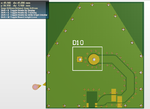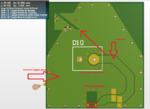Sherry1
Member level 3
- Joined
- Apr 4, 2013
- Messages
- 61
- Helped
- 0
- Reputation
- 0
- Reaction score
- 0
- Trophy points
- 1,286
- Location
- Manchester, UK
- Activity points
- 1,810
I am making a feed trace on a FR4 PCB for my antenna. There is a ground pour around it and then VIAs take the Ground plane to a layer below. Is there a formula to calculate the distance between Feed and Ground Pour ?
I am already using a formula to calculate track width for Feed line . But do not know any formula or rule of thumb to keep the distance between Feed line and Copper ground pour. Is there any?
The track I have made is shown in the diagram. Right now the gap between Feed-Ground pour is very narrow.
Thanks in advance

I am already using a formula to calculate track width for Feed line . But do not know any formula or rule of thumb to keep the distance between Feed line and Copper ground pour. Is there any?
The track I have made is shown in the diagram. Right now the gap between Feed-Ground pour is very narrow.
Thanks in advance

